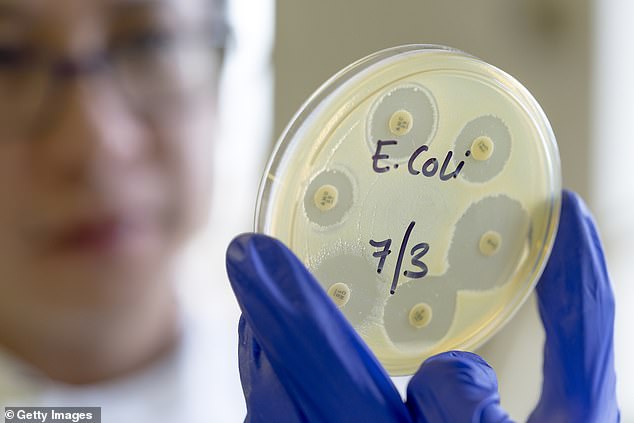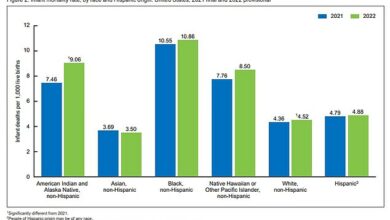E.coli on the rise as infections rise by more than 4,000 a year, new data shows – amid concerns over Britain’s contaminated water supply


New government figures show that the number of serious cases of E. coli has increased by more than 4,000 in one year, the largest annual increase in four years.
Analysis of the latest data by MailOnline shows that infections have risen by around 10 per cent since last year, with more than 46,000 cases in England between June 2023 and June 2024.
Over the past three years we have seen much smaller increases of around four percent.
The bacteria, which can spread through contaminated water, food or other infected people, usually causes fever, nausea and diarrhea.
In most cases, the symptoms disappear within a few days. However, for vulnerable people with weakened immune systems, it can be fatal.
Infectious disease experts said today that the rise – which is linked to blood-test-confirmed E. coli, mostly in a hospital setting – is likely due to an increase in elective surgery and the number of elderly people in hospital.
Paul Hunter, professor of medicine at the University of East Anglia and a specialist in bacterial infections, said: ‘Most cases are discovered in seriously ill patients who have been admitted to hospital for something else and have either contracted the disease in hospital or they already have it and it is discovered by chance by doctors.
‘They will almost certainly be in hospital when they are diagnosed, because it is very difficult to test for the infection in general practice.’
However, Professor Hunter adds that the type of E. coli found in hospital is not the same as the type you can get from spoiled chicken or dirty water.
“One of the most common causes of E. coli bacteremia is urinary tract infections, where bacteria from the bladder enter the bloodstream through the genitals,” he said.
“Bacteremia means bacteria in the blood. When they start spreading and growing in your bloodstream, you get really sick.”
He added that there is “no single reason” for the intriguing rise in serious E. coli cases this year.
“Some of it may be because more labs are reporting cases. It may also be because we’re doing more elective surgery, which is a known risk of E. coli.”
Hospitals are also seeing more older people with respiratory illnesses, including RSV, he said.
‘As you get older, you’re more likely to have a urinary catheter, which is a big risk factor.
‘It is also true that as you get older, you can develop more intestinal problems. These can eventually lead to bacteria entering the blood.’
The data, released on Wednesday by the UK Health Security Agency (UKHSA), showed the NHS in England recorded 46,416 cases in 2023/24.
For comparison, in 2022/23 and 2021/22, 42,662 and 41,087 cases were registered respectively.
Even before the pandemic, this number was only 44,257 in 2019/2020.
Individual, Experts have long been concerned about Shiga toxin-producing E. coli (STEC), a strain of the diarrhea-causing bacteria.
According to UKHSA, symptoms of infection range from stomach cramps and vomiting to bloody diarrhea, with about half of infected people experiencing the latter.
However, it is often difficult to recognize, because the same symptoms can be caused by different bacteria, including the norovirus.
STEC is considered extremely contagious and in as many as 15 percent of cases the bacteria can cause hemolytic uremic syndrome (HUS), a life-threatening condition that can lead to kidney failure.

More than 46,000 cases of E. coli bacteraemia detected in the blood were recorded in England between June 2023 and June 2024. That is an increase of almost 10 per cent on the previous year.
STEC can also be spread by direct contact with infected animals or their feces, but also by direct contact with the feces of infected people, for example in the case of caregivers caring for the elderly.
It can also be spread through contaminated water, for example by drinking contaminated products or accidentally ingesting it while swimming.
Earlier this year, a fatality was attributed to a STEC outbreak that probably caused by contaminated lettuce leaves.
More than 60 Sandwiches, wraps and salads sold in 11 major stores across the UK were also with ‘do not eat’ warnings for fear that they might contain STEC.
Experts believe the texture of lettuce increases the risk of E. coli contamination, even if the water is contaminated with contaminated animal feces. They also believe that lettuce is not cooked, which normally kills the bugs.
According to official figures, the number of times sewage has been discharged into English waters has increased by a factor of 24 since 2016.
It comes as Britons were told this week they are at particularly high risk of contracting the disease, which is causing at least 120 hospital admissions each year, this summer due to unusually high rainfall.
Previous research has shown that many British waters, including the River Thames and the River Tone in Somerset, have alarmingly high levels of E. coli. The bacteria can also be found in meat and other foods.
Large volumes of rainwater can increase the presence of the bacteria due to UK water regulations.
Water companies are allowed to discharge sewage into open water after heavy rainfall to prevent the system from becoming overloaded.
But according to activists, these types of leaks happen too often.
According to official figures, the number of times sewage has been discharged into English waters has increased by a factor of 24 since 2016.
Britons are advised to contact NHS 111 or their GP if they or their children show symptoms of an E. coli infection.
In children under five years of age, the following symptoms may occur: decreased interest in breastfeeding or bottle feeding and signs of dehydration, such as fewer wet diapers.
Both adults and children are advised to call NHS 111 or their GP if they have been vomiting for two days or have diarrhoea for a week.
If you experience bloody diarrhoea or bleeding from your anus, call NHS 111 or your GP immediately.
People who are infected are advised not to return to work, school or daycare until 48 hours after symptoms disappear.




